Collaborative projects
Collaborative projects between UoN and BGS related to past environmental and climate change.
Has climate forced evolution in the oldest lake in Europe?
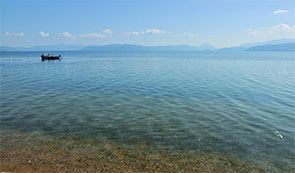
Lake Ohrid in the Balkans (Macedonia, Albania) is a unique aquatic ecosystem and a hotspot of freshwater biodiversity with more than 210 endemic species described. The lake is considered to be the oldest, continuously existing lake in Europe. Age estimations vary between one and ten million years, with a focus between two and three million years, and both marine and limnic origin is proposed. Extant sedimentary records span the last glacial/interglacial cycle (last ca. 130.000 years) and reveal that Lake Ohrid is a valuable archive of volcanic ash dispersal, tectonic activity, and climate change in the central northern Mediterranean region. The current international deep drilling project on Lake Ohrid will thus help (i) to obtain more precise information about the age and origin of the lake, (ii) to unravel the seismotectonic history of the lake area, (iii) to obtain a continuous record containing information on volcanic activities and climate changes in the central northern Mediterranean region, and (iv) to better understand the impact of major geological/environmental events on shaping an extraordinary degree of endemic biodiversity as a matter of global significance. The drilling was conducted in spring 2013 in the central basin where the maximal sediment thickness is ~680 m and where the complete history of the lake is likely recorded. Jack Lacey (formerly UoN, now BGS) undertook his Centre for Environmental Geochemistry sponsored PhD research on Lake Ohrid and continues to play a leading role in the project in association with Melanie Leng and Matt Jones.
Human Impact on Malaysian Wetlands
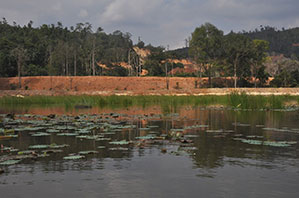
Exponential population growth, urban expansion and climate change are changing the quality of freshwaters, especially in Asia. Tasik Chini is one of the few naturally occurring lakes in Malaysia, and the ecosystem of this UNESCO Man and Biosphere site is currently under extreme pressure due to forest clearing for palm oil plantations, bauxite mining on the lake shores, and the construction of a weir for tourist activities. As a result, the Tasik Chini ecosystem has shown a loss of biodiversity and a decrease in its native lotus population. Researchers at UoN and BGS including Dr Stefan Engels, Dr Suzanne McGowan, Prof Melanie Leng, Dr Keely Mills, Professor Sarah Metcalfe (all UoN and BGS) are collaborating with local partners to reconstruct palaeoenvironmental change at the Tasik Chini site, aiming to identify the major environmental drivers and to disentangle their effects. Changes in the pollution history over the last few centuries will be reconstructed using a combination of physical and geochemical proxy-indicators (in collaboration with Simon Chenery, Chris Vane, Charles Gowing, BGS) where the lake ecosystem response to these changes will be analysed using diatoms, sedimentary pigments and other palaeoecological techniques. The project has just started and will run from 2016–2019.
Bering Sea Pleistocene palaeoceanography and climate change
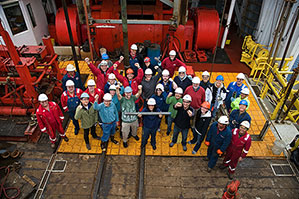
The Bering Sea is the third largest marginal sea in the world. It provides the critical link between the Arctic Ocean and the Pacific Ocean, and harbors a rich ecosystem forced by the interaction of sea ice, atmospheric circulation, and upwelling ancient deep water (Asahi et al., 2014; Kaminski et al., 2013). This project is part of International Ocean Discovery Program (IODP) Expedition 323 which sailed to the Bering Sea in 2009). Researchers include Sev Kender (UoN), Melanie Leng (UoN/BGS), Christina Ravelo (UC Santa Cruz), George Swann (UoN), Sarah Metcalfe (UoN), James Riding (BGS), Ivano Aiello (Moss Landing), Zuzanna Stroynowski (INETI), Henrieka Detlef (Cardiff), Sindia Sosdian (Cardiff) and Ian Hall (Cardiff). The palaeoceanography of the past ˜2 million years (the Pleistocene) is being reconstructed with the use of benthic foraminiferal assemblages and stable isotopes, palynology and trace metal analysis. The aims are to reconstruct sea surface conditions (e.g. sea ice, productivity) and bottom water conditions (e.g. temperature), over critical climate cooling transitions during the mid Pleistocene. Funding has been provided by two NERC Isotope Geosciences Facilities (BGS) grants (2010 and 2014), and high resolution analysis will be extended through the entire mid Pleistocene by new PhD researcher Savannah Worne (UoN), who's studentship was awarded to Sev Kender, George Swann and Sarah Metcalfe by the Envision NERC DTP.
Climate change at the Palaeocene–Eocene Thermal Maximum (PETM)
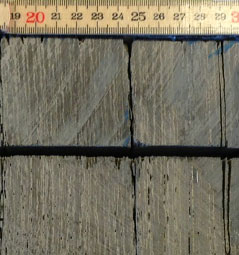
The PETM was a period of intense and rapid global warming ˜55.5 million years ago, caused by massive CO2 release to the atmosphere-ocean system. It has been considered the best geological analogue for current CO2 release and future global warming. The cause of the carbon release is not yet known, but North Atlantic Igneous Province activity is one hypothesis that should have left its signature in proximal North Sea sediments which we are analysing (Kender et al. 2012). Researchers involved include Sev Kender (UoN), James Riding (BGS), Melanie Leng (UoN/BGS), Karen Dybkjær (Danish Geological Survey), Gunver Pedersen (Danish Geological Survey), Simon Kemp (BGS), Chris Vane (BGS), Mike Ellis (BGS), Kara Bogus (IODP/Texas A&M) and, Thomas Wagner (Newcastle). Changes to the carbon cycle in the North Sea are being reconstructed with the use of carbon isotopes, organic carbon biomarkers, and bulk sediment geochemistry. Changes to regional vegetation will be reconstructed using palynology. Funding has been provided by a NERC Isotope Geosciences Facilities (BGS) grant (2015). The results should allow us to detect the environmental impacts of any volcanism in the region, and environmental changes in NW Europe forced by global warming.
Recent environmental change in West Greenland

There are hundreds of lakes on the western Greenland margin. Researchers at UoN and BGS including Dr Suzanne McGowan, Prof Melanie Leng and Dr Matthew Jones have been collaborating for over a decade in the Kangerlussuaq and Disko Island areas using lake sediments to reconstruct palaeoenvironmental change (Leng and Anderson 2003, Anderson et al 2008, Liversidge et al. 2012). Recent work is investigating lake carbon processing on Holocene timescales and its potential influence on regional carbon budgets through a NERC-funded project (with Dr Suzanne McGowan UoN, Prof N. John Anderson and Dr Erika Hogan Loughborough University, Dr Viv Jones UCL, Prof Mary Edwards and Dr Peter Langdon University of Southampton), and an EU-INTERACT-funded and NERC Isotope Geosciences Facilities (BGS)-funded project (with UoN NERC-ESRC-funded PhD student Mark Stevenson, Dr Suzanne McGowan and Dr George Swann UoN, Dr Emma Pearson Newcastle University, Prof Melanie Leng UoN/BGS and Dr Erika Hogan Loughborough University).
Climate variation and melting around Antarctica
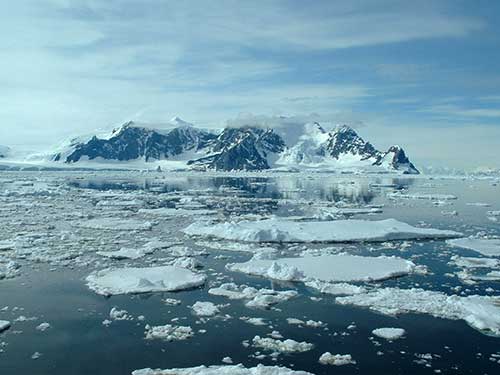
Research is being undertaken on trying to understand how climate variation over the last 12 000 years has impacted on the Antarctic ice cap and melt water flux into the Southern Ocean and how this might influence ocean currents in the future. In particular a NERC funded project (with Prof Melanie Leng UoN/BGS, Dr George Swann UoN, Dr Andrea Snelling BGS, and Dr Jenny Pike University of Cardiff) has shown the impact of how changes in climate of the equatorial eastern Pacific Ocean influences melting along the Antarctic Peninsula (Pike et al. 2013, Swann et al. 2013). A forward project now also including Dr Vicky Peck and Dr Claire Allan (British Antarctic Survey) and Dr Alistair Graham (University of Exeter), with a new PhD student and Research Fellow (both UoN), will further look at the influence of the South Westerlies and the El Niño Southern Oscillation climate system on ocean water masses and changes in freshwater flux into the ocean in the sub-Antarctic around the South Georgia Islands.
Mediterranean climate change
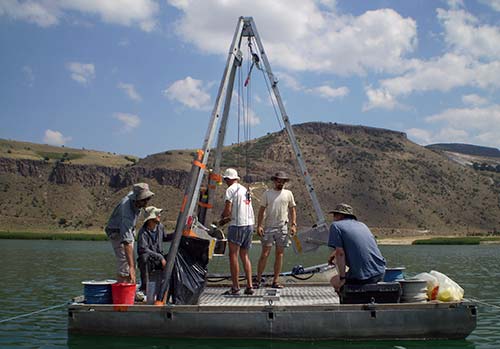
The Mediterranean region has a large number of lakes which accumulate sediments from which climate information can be gained using geochemical techniques. Understanding past variation in climate and hydrology in the Mediterranean is vital for establishing future climate scenarios and assessing the potential impact on human populations (Leng et al. 2010), as changes in water resources and rainfall are predicted to have important social, economic and political impacts across the region. Projects including Prof Melanie Leng UoN/BGS, Dr Matt Jones and Prof Sarah Metcalfe UoN in collaboration with Prof Neil Roberts (Plymouth), Dr Warren Eastwood (Birmingham) and others have made particular use of isotope techniques. Some important records have been gained from Turkey (Jones et al. 2006, Dean et al. 2013) and the Balkans (Leng et al. 2013), and we have been able to compile a regional synthesis of change (Roberts et al. 2008). A recently completed PhD project (Dr Jonathan Dean, UoN/BGS) has looked at climate through key time periods of human societal development such as the beginnings of agriculture and the collapse of the Akkadian Empire, to begin to test hypotheses around climate driven societal change. Future work will develop this focus on periods of archaeological interest and expand our knowledge to the east towards Iran and westwards to Spain.
Silicon cycling in Malaysian mangrove systems
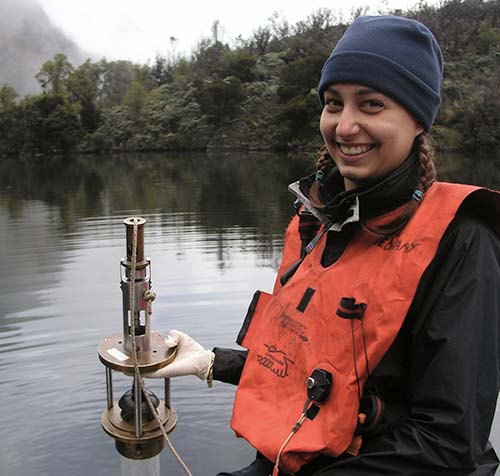
A recently appointed Anne McLaren Fellow at UoN, Dr Virginia Panizzo will be researching into global budgets of silicon cycling, by providing the first estimates of its sources, sinks and fluxes in coastal mangrove systems. Silicon acts as the building blocks for primary algal productivity and, as a result, has a strong control on global carbon cycles and the inventory of CO2 in the atmosphere. The implications of this research are crucial for the mitigation of future climate change and builds on Ginnie’s previous Si cycling research (Panizzo et al. in press). This project is in conjunction with Dr Matthew Horstwood and Vanessa Pashley (both BGS), Dr Barry Lomax (UoN), Dr Suzanne McGowan (UoN Malaysia Campus) and Prof Rozainah Zakaria and Prof Chong Ving Ching (University of Malaya). Ginnie took up this Fellowship in April 2015.
Investigation of geochemical changes through decay and degradation
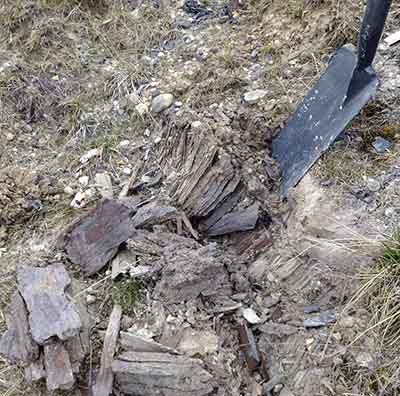
Research between the BGS and UoN is being undertaken to elucidate the effects of plant-decay by insects in coastal mangroves . The aim is to understand how above-ground processes help chemically stabilise below-ground peats. Dr Christopher Vane BGS and Prof Colin Snape UoN are using organic geochemistry to show that termites selectively decompose woody stems and that their large nests are mainly comprised of altered lignin and low quantities of cellulose (Vane et al. 2013). Preservation of organic matter is also important in investigations of atmospheric CO2 levels from the past. Under normal circumstances wood is partially decayed by fungi and bacteria and then further altered upon deep burial by the effects of pressure and temperature. In combination, these degradations mask the original climate signal contained in the wood’s biochemical structure (Vane et al. 2006). New research by Dr Christopher Vane BGS and Prof Colin Snape UoN aims to overcome this challenge by investigating the chemical composition of mummified woods that have been protected from microbial and coalification reactions by a unique mode of fast burial (with Dr Jim Riding BGS).
Modern process hydrology

Numerous palaeoclimate records from isotope data have been published over the last few decades and yet interpretations of these records tend to be based only on conceptual models and regression relationships between waters and climatic and/or hydrological variables in the present day. Dr Matt Jones UoN and Prof Melanie Leng UoN/BGS, in collaboration with Dr Jon Tyler (University of Adelaide), Dr Suzanne McGowan UoN and others have shown that modern process monitoring needs to inform on how isotopes should be used to reconstruct hydrological and climate change in the past through various UoN and NERC funded projects (Jones et al. 2007).
Variability in the North American (Mexican) monsoon
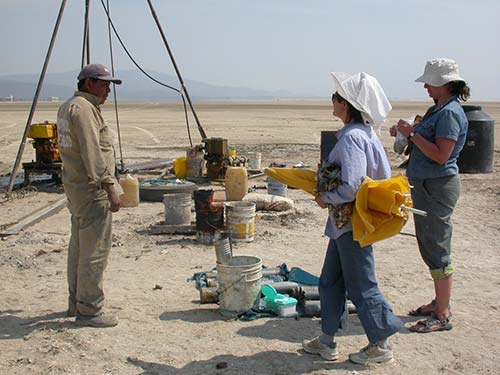
Research is being carried out into the nature and possible drivers of change in the North American (or Mexican) Monsoon (NAM) over a range of timescales varying from the last 1000 years to the last 70 000 years. Multi-proxy studies of lake sediment cores focus on hydrological evidence for climatic change (runoff, lake level change) using stable isotopes, diatoms, organic geochemistry and XRF core scanning. UK collaborators on this project area include Prof Sarah Metcalfe and Dr Matthew Jones UoN, Prof Melanie Leng UoN/BGS, Dr Christopher Vane BGS, Dr Sarah Davies Aberystwyth University, Prof Jonathan Holmes UCL, Dr Simon Kemp BGS and Dr Anthony Newton University of Edinburgh. The work is being developed through a NERC grant on climate variability over the circum-Caribbean region (with Prof Holmes and collaborators in Mexico and Jamaica). High resolution climate records from laminated sediment sequences will be extended through a new PhD studentship awarded to Dr Matthew Jones and Prof Sarah Metcalfe by the Envision NERC DTP
Prof Sarah Metcalfe and Prof Melanie Leng are also involved in research around the timing of human occupation of Mexico with Dr Nicolas Felstead (University of Durham) (Felstead et al. 2013).
Environmental changes in Lake Baikal, Siberia
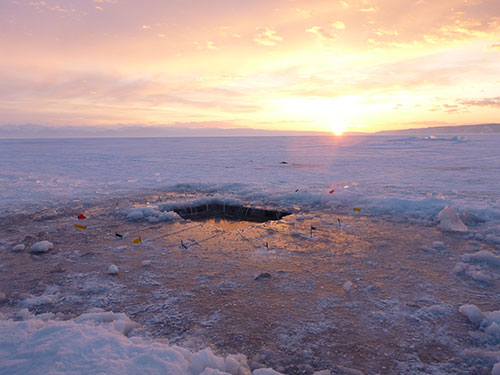
Lake Baikal is the world's oldest, deepest and most voluminous lake lying in a rift zone in south eastern Siberia that began to form over 20 million years ago. Today this World Heritage Site contains around 20 per cent of global surface freshwater and over 2500 flora and fauna, the majority of which are endemic. Researchers at UoN (Dr George Swann, Dr Suzanne McGowan, Dr Virginia Panizzo) and BGS (Dr Matthew Horstwood, Prof Melanie Leng (UoN/BGS)) in collaboration with the colleagues at UCL (Prof Anson Mackay) and the Institute of Earth's Crust SB RAS (Irkutsk, Russia) are using silicon isotopes and pigment analyses as part of a NERC-funded project to quantify biogeochemical cycling in the lake. A UoN PhD (Sarah Roberts) is also involved with the project specifically on pollution impacts. The results of this will allow the researchers to examine how environmental changes and anthropogenic activity in the catchment have impacted the lake during the 21st and 20th Century and assess the response of the lake to natural climatic changes that have occurred over the last 1000 years.
